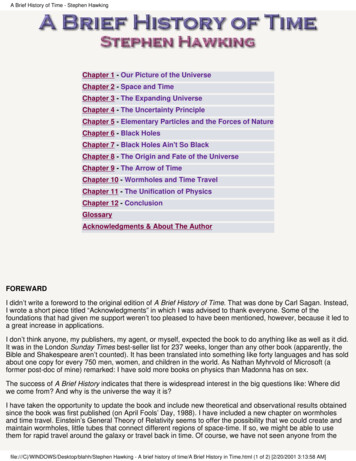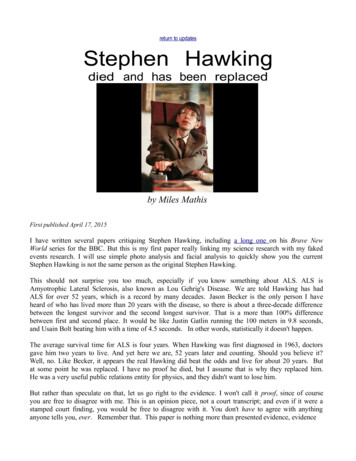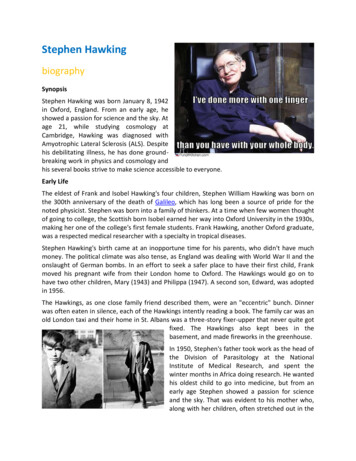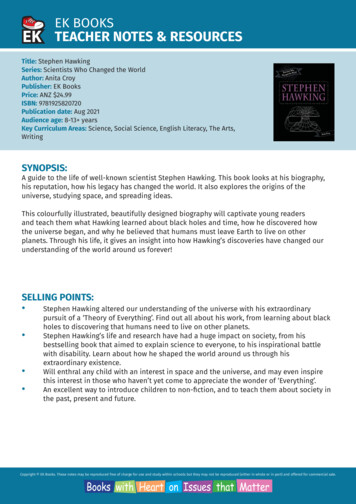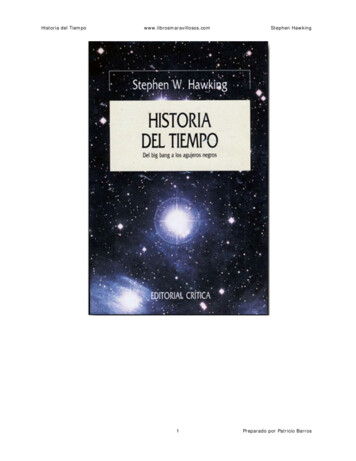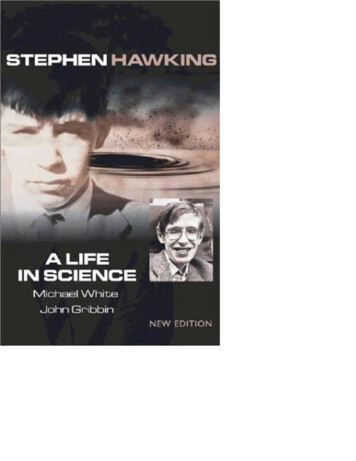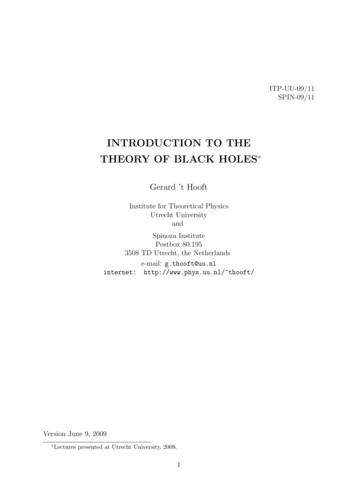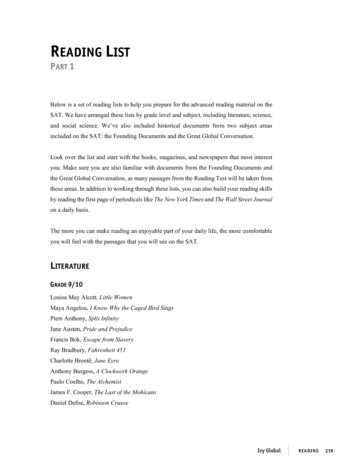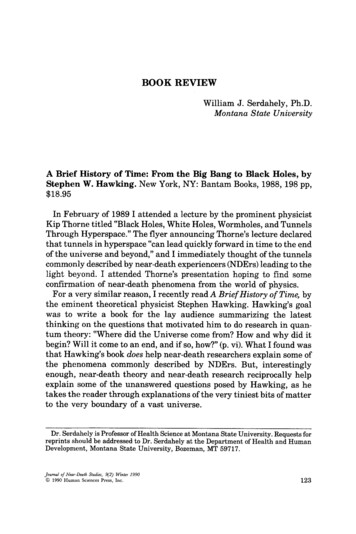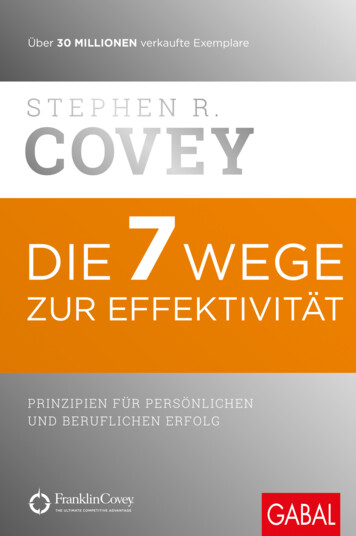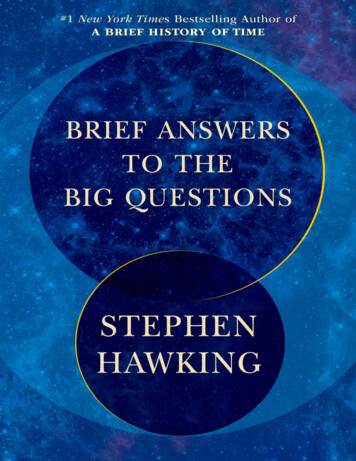
Transcription
Copyright 2018 by Spacetime Publications LimitedForeword copyright 2018 by Eddie RedmayneIntroduction copyright 2018 by Kip ThorneAfterword copyright 2018 by Lucy HawkingAll rights reserved.Published in the United States by Bantam Books, an imprint of RandomHouse, a division of Penguin Random House LLC, New York.BANTAM BOOKS and the HOUSE colophon are registered trademarks ofPenguin Random House LLC.Published in the United Kingdom by John Murray (Publishers), aHachette UK Company.Photograph of the adult Stephen Hawking Andre PattendenHardback ISBN 9781984819192Ebook ISBN 9781984819208randomhousebooks.comText design by Craig Burgess, adapted for ebookCover design: Dan RembertCover image: Shutterstockv5.3.2ep
ContentsCoverTitle PageCopyrightA Note from the PublisherForeword: Eddie RedmayneAn Introduction: Kip ThorneWhy We Must Ask the Big QuestionsChapter 1: Is There a God?Chapter 2: How Did It All Begin?Chapter 3: Is There Other Intelligent Life in the Universe?Chapter 4: Can We Predict the Future?Chapter 5: What Is Inside a Black Hole?Chapter 6: Is Time Travel Possible?Chapter 7: Will We Survive on Earth?Chapter 8: Should We Colonise Space?Chapter 9: Will Artificial Intelligence Outsmart Us?Chapter 10: How Do We Shape the Future?Afterword: Lucy HawkingAcknowledgementsBy Stephen HawkingAbout the Author
A Note from the PublisherStephen Hawking was regularly asked for his thoughts on the “bigquestions” of the day by scientists, tech entrepreneurs, senior businessfigures, political leaders and the general public. Stephen maintained anenormous personal archive of his responses, which took the form ofspeeches, interviews and essays.This book draws from this personal archive and was in development atthe time of his death. It has been completed in collaboration with hisacademic colleagues, his family and the Stephen Hawking Estate.A percentage of the royalties will go to the Motor Neurone DiseaseAssociation and the Stephen Hawking Foundation.
ForewordEddie RedmayneThe first time I met Stephen Hawking, I was struck by his extraordinarypower and his vulnerability. The determined look in his eyes coupled withthe immobile body was familiar to me from my research—I had recentlybeen engaged to play the role of Stephen in The Theory of Everythingand had spent several months studying his work and the nature of hisdisability, attempting to understand how to use my body to express thepassage of motor neurone disease over time.And yet when I finally met Stephen, the icon, this scientist ofphenomenal talent, whose main communication was through acomputerised voice along with a pair of exceptionally expressiveeyebrows, I was floored. I tend to get nervous in silences and talk toomuch whereas Stephen absolutely understood the power of silence, thepower of feeling like you are being scrutinised. Flustered, I chose to talkto him about how our birthdays were only days apart, putting us in thesame zodiacal sign. After a few minutes Stephen replied, “I’m anastronomer. Not an astrologer.” He also insisted that I call him Stephenand stop referring to him as Professor. I had been told The opportunity to portray Stephen was an extraordinary one. I wasdrawn to the role because of the duality of Stephen’s external triumph inhis scientific work and the internal battle against motor neurone diseasestarting in his early twenties. His was a unique, complex, rich story ofhuman endeavour, family life, huge academic achievement and sheerdefiance in the face of all obstacles. While we wanted to portray theinspiration, we also wanted to show the grit and courage involved inStephen’s life, displayed both by him and by those who cared for him.But it was equally important to portray that side of Stephen which was
pure showman. In my trailer I ended up having three images that Ireferred to. One was Einstein with his tongue out, because there’s thatsimilar playful wit with Hawking. Another was the Joker in a pack ofcards who’s a puppeteer, because I feel Stephen always had people in thepalm of his hand. And the third was James Dean. And that was what Igained from seeing him—the glint and the humour.The greatest pressure in playing a living person is that you will have toaccount for your performance to the person you have portrayed. InStephen’s case, the accounting was also to his family, who had been sogenerous to me during my preparation for the film. Before Stephen wentinto the screening, he said to me, “I will tell you what I think. Good. Orotherwise.” I replied that if it was “otherwise” perhaps he could just say“otherwise” and spare me the excoriating details. Generously, Stephensaid he had enjoyed the film. He was moved by it, but famously he alsostated that he thought there should have been more physics and fewerfeelings. This is impossible to argue with.Since The Theory of Everything, I have stayed in contact with theHawking family. I was touched to be asked to give a reading at Stephen’sfuneral. It was an incredibly sad but brilliant day, full of love and joyfulmemories and reflections on this most courageous of men, who had ledthe world in his science and in his quest to have disabled peoplerecognised and given proper opportunities to thrive.We have lost a truly beautiful mind, an astonishing scientist and thefunniest man I have ever had the pleasure to meet. But as his family saidat the time of Stephen’s death, his work and legacy will live on and so it iswith sadness but also great pleasure that I introduce you to this collectionof Stephen’s writings on diverse and fascinating topics. I hope you enjoyhis writings and, to quote Barack Obama, I hope Stephen is having fun upthere among the stars.LoveEddie
An IntroductionProfessor Kip S. ThorneI first met Stephen Hawking in July 1965, in London, England, at aConference on General Relativity and Gravitation. Stephen was in themidst of his PhD studies at the University of Cambridge; I had justcompleted mine at Princeton University. Rumours swirled around theconference halls that Stephen had devised a compelling argument thatour universe must have been born at some finite time in the past. Itcannot be infinitely old.So, along with some 100 people, I squeezed into a room designed forforty, to hear Stephen speak. He walked with a cane and his speech was abit slurred, but otherwise he showed only modest signs of the motorneurone disease with which he had been diagnosed just two years earlier.His mind was clearly unaffected. His lucid reasoning relied on Einstein’sgeneral relativity equations, and on astronomers’ observations that ouruniverse is expanding, and on a few simple assumptions that seemed verylikely to be true, and it made use of some new mathematical techniquesthat Roger Penrose had recently devised. Combining all these in waysthat were clever, powerful and compelling, Stephen deduced his result:our universe must have begun in some sort of singular state, roughly tenbillion years ago. (Over the next decade, Stephen and Roger, combiningforces, would go on to prove, ever more convincingly, this singularbeginning of time, and also prove ever more convincingly that the core ofevery black hole is inhabited by a singularity where time ends.)I emerged from Stephen’s 1965 lecture tremendously impressed. Notjust by his argument and conclusion, but more importantly by hisinsightfulness and creativity. So I sought him out and spent an hourtalking privately with him. That was the beginning of a lifelong
friendship, a friendship based not just on common science interests, buton a remarkable mutual sympathy, an uncanny ability to understand eachother as human beings. Soon we were spending more time talking aboutour lives, our loves, and even death than about science, though ourscience was still much of the glue that bound us together.In September 1973 I took Stephen and his wife Jane to Moscow,Russia. Despite the raging Cold War, I had been spending a month or soin Moscow every other year since 1968, collaborating on research withmembers of a group led by Yakov Borisovich Zel’dovich. Zel’dovich was asuperb astrophysicist, and also a father of the Soviet hydrogen bomb.Because of his nuclear secrets, he was forbidden to travel to WesternEurope or America. He craved discussions with Stephen; he could notcome to Stephen; so we went to him.In Moscow, Stephen wowed Zel’dovich and hundreds of other scientistswith his insights, and in return Stephen learned a thing or two fromZel’dovich. Most memorable was an afternoon that Stephen and I spentwith Zel’dovich and his PhD student Alexei Starobinsky in Stephen’sroom in the Rossiya Hotel. Zel’dovich explained in intuitive ways aremarkable discovery they had made, and Starobinsky explained itmathematically.To make a black hole spin requires energy. We already knew that. Ablack hole, they explained, can use its spin energy to create particles, andthe particles will fly away carrying the spin energy with them. This wasnew and surprising—but not terribly surprising. When an object hasenergy of motion, nature usually finds a way to extract it. We alreadyknew other ways of extracting a black hole’s spin energy; this was just anew, though unexpected way.Now, the great value of conversations like this is that they can triggernew directions of thought. And so it was with Stephen. He mulled overthe Zel’dovich/Starobinsky discovery for several months, looking at itfirst from one direction and then from another, until one day it triggereda truly radical insight in Stephen’s mind: after a black hole stopsspinning, the hole can still emit particles. It can radiate—and it radiatesas though the black hole was hot, like the Sun, though not very hot, justmildly warm. The heavier the hole, the lower its temperature. A hole thatweighs as much as the Sun has a temperature of 0.00000006 Kelvin,
0.06 millionths of a degree above absolute zero. The formula forcalculating this temperature is now engraved on Stephen’s headstone inWestminster Abbey in London, where his ashes reside between those ofIsaac Newton and Charles Darwin.This “Hawking temperature” of a black hole and its “Hawkingradiation” (as they came to be called) were truly radical—perhaps themost radical theoretical physics discovery in the second half of thetwentieth century. They opened our eyes to profound connectionsbetween general relativity (black holes), thermodynamics (the physics ofheat) and quantum physics (the creation of particles where before therewere none). For example, they led Stephen to prove that a black hole hasentropy, which means that somewhere inside or around the black holethere is enormous randomness. He deduced that the amount of entropy(the logarithm of the hole’s amount of randomness) is proportional to thehole’s surface area. His formula for the entropy is engraved on Stephen’smemorial stone at Gonville and Caius College in Cambridge, where heworked.For the past forty-five years, Stephen and hundreds of other physicistshave struggled to understand the precise nature of a black hole’srandomness. It is a question that keeps on generating new insights aboutthe marriage of quantum theory with general relativity—that is, about theill-understood laws of quantum gravity.In autumn 1974 Stephen brought his PhD students and his family (hiswife Jane and their two children Robert and Lucy) to Pasadena,California for a year, so that he and his students could participate in theintellectual life of my university, Caltech, and merge, temporarily, withmy own research group. It was a glorious year, at the pinnacle of whatcame to be called “the golden age of black hole research.”During that year, Stephen and his students and some of mine struggledto understand black holes more deeply, as did I to some degree. ButStephen’s presence, and his leadership in our joint group’s black holeresearch, gave me freedom to pursue a new direction that I had beencontemplating for some years: gravitational waves.There are only two types of waves that can travel across the universebringing us information about things far away: electromagnetic waves(which include light, X-rays, gamma rays, microwaves, radio waves );
and gravitational waves.Electromagnetic waves consist of oscillating electric and magneticforces that travel at light speed. When they impinge on charged particles,such as the electrons in a radio or TV antenna, they shake the particlesback and forth, depositing in the particles the information the wavescarry. That information can then be amplified and fed into a loudspeakeror on to a TV screen for humans to comprehend.Gravitational waves, according to Einstein, consist of an oscillatoryspace warp: an oscillating stretch and squeeze of space. In 1972 Rainer(Rai) Weiss at the Massachusetts Institute of Technology had invented agravitational-wave detector, in which mirrors hanging inside the cornerand ends of an L-shaped vacuum pipe are pushed apart along one leg ofthe L by the stretch of space, and pushed together along the other leg bythe squeeze of space. Rai proposed using laser beams to measure theoscillating pattern of this stretch and squeeze. The laser light couldextract a gravitational wave’s information, and the signal could then beamplified and fed into a computer for human comprehension.The study of the universe with electromagnetic telescopes(electromagnetic astronomy) was initiated by Galileo, when he built asmall optical telescope, pointed it at Jupiter and discovered Jupiter’s fourlargest moons. During the 400 years since then, electromagneticastronomy has completely revolutionised our understanding of theuniverse.In 1972 my students and I began thinking about what we might learnabout the universe using gravitational waves: we began developing avision for gravitational-wave astronomy. Because gravitational waves area form of space warp, they are produced most strongly by objects thatthemselves are made wholly or partially from warped space–time—whichmeans, especially, by black holes. Gravitational waves, we concluded, arethe ideal tool for exploring and testing Stephen’s insights about blackholes.More generally, it seemed to us, gravitational waves are so radicallydifferent from electromagnetic waves that they were almost guaranteed tocreate their own, new revolution in our understanding of the universe,perhaps comparable to the enormous electromagnetic revolution thatfollowed Galileo—if these elusive waves could be detected and monitored.
But that was a big if: we estimated that the gravitational waves bathingthe Earth are so weak that mirrors at the ends of Rai Weiss’s L-shapeddevice would be moved back and forth relative to each other by no morethan 1/100th the diameter of a proton (which means 1/10,000,000th ofthe size of an atom), even if the mirror separation was several kilometres.The challenge of measuring such tiny motions was enormous.So during that glorious year, with Stephen’s and my research groupsmerged at Caltech, I spent much of my time exploring the prospects forgravitational-wave success. Stephen was helpful in this as, several yearsearlier, he and his student Gary Gibbons had designed a gravitationalwave detector of their own (which they never built).Shortly after Stephen’s return to Cambridge, my exploration reachedfruition with an all-night, intense discussion between Rai Weiss and mein Rai’s hotel room in Washington DC. I became convinced that theprospects for success were great enough that I should devote most of myown career, and my future students’ research, to helping Rai and otherexperimenters achieve our gravitational-wave vision. And the rest, as theysay, is history.On September 14, 2015, the LIGO gravitational-wave detectors (builtby a 1,000-person project that Rai and I and Ronald Drever co-founded,and Barry Barish organised, assembled and led) registered their firstgravitational waves. By comparing the wave patterns with predictionsfrom computer simulations, our team concluded that the waves wereproduced when two heavy black holes, 1.3 billion light years from Earth,collided. This was the beginning of gravitational-wave astronomy. Ourteam had achieved, for gravitational waves, what Galileo achieved forelectromagnetic waves.I am confident that, over the coming several decades, the nextgeneration of gravitational-wave astronomers will use these waves notonly to test Stephen’s laws of black hole physics, but also to detect andmonitor gravitational waves from the singular birth of our universe, andthereby test Stephen’s and others’ ideas about how our universe came tobe.During our glorious year of 1974–5, while I was dithering overgravitational waves, and Stephen was leading our merged group in blackhole research, Stephen himself had an insight even more radical than his
discovery of Hawking radiation. He gave a compelling, almost airtightproof that, when a black hole forms and then subsequently evaporatesaway completely by emitting radiation, the information that went into theblack hole cannot come back out. Information is inevitably lost.This is radical because the laws of quantum physics insistunequivocally that information can never get totally lost. So, if Stephenwas right, black holes violate a most fundamental quantum mechanicallaw.How could this be? The black hole’s evaporation is governed by thecombined laws of quantum mechanics and general relativity—the illunderstood laws of quantum gravity; and so, Stephen reasoned, the fierymarriage of relativity and quantum physics must lead to informationdestruction.The great majority of theoretical physicists find this conclusionabhorrent. They are highly sceptical. And so, for forty-four years theyhave struggled with this so-called information-loss paradox. It is astruggle well worth the effort and anguish that have gone into it, sincethis paradox is a powerful key for understanding the quantum gravitylaws. Stephen himself, in 2003, found a way that information mightescape during the hole’s evaporation, but that did not quell theorists’struggles. Stephen did not prove that the information escapes, so thestruggle continues.In my eulogy for Stephen, at the interment of his ashes at WestminsterAbbey, I memorialised that struggle with these words: “Newton gave usanswers. Hawking gave us questions. And Hawking’s questionsthemselves keep on giving, generating breakthroughs decades later.When ultimately we master the quantum gravity laws, and comprehendfully the birth of our universe, it may largely be by standing on theshoulders of Hawking.” Just as our glorious 1974–5 year was only the beginning for mygravitational-wave quest, so it also was just the beginning for Stephen’squest to understand in detail the laws of quantum gravity and what those
laws say about the true nature of a black hole’s information andrandomness, and also about the true nature of our universe’s singularbirth, and the true nature of the singularities inside black holes—the truenature of the birth and death of time.These are big questions. Very big.I have shied away from big questions. I don’t have enough skills,wisdom or self-confidence to tackle them. Stephen, by contrast, wasalways attracted to big questions, whether they were deeply rooted in hisscience or not. He did have the necessary skills, wisdom and selfconfidence.This book is a compilation of his answers to the big questions, answerson which he was still working at the time of his death.Stephen’s answers to six of the questions are deeply rooted in hisscience. (Is there a God? How did it all begin? Can we predict the future?What is inside a black hole? Is time travel possible? How do we shape thefuture?). Here you will find him discussing in depth the issues that I’vedescribed briefly in this Introduction, and also much, much more.His answers to the other four big questions cannot possibly be rootedsolidly in his science. (Will we survive on Earth? Is there other intelligentlife in the universe? Should we colonise space? Will artificial intelligenceoutsmart us?) Nevertheless, his answers display deep wisdom andcreativity, as we should expect.I hope you find his answers as stimulating and insightful as do I. Enjoy!Kip S. ThorneJuly 2018
WHY WE MUST ASK THE BIGQUESTIONS
P eople have always wanted answers to the big questions. Where did wecome from? How did the universe begin? What is the meaning and designbehind it all? Is there anyone out there? The creation accounts of the pastnow seem less relevant and credible. They have been replaced by a varietyof what can only be called superstitions, ranging from New Age to StarTrek. But real science can be far stranger than science fiction, and muchmore satisfying.I am a scientist. And a scientist with a deep fascination with physics,cosmology, the universe and the future of humanity. I was brought up bymy parents to have an unwavering curiosity and, like my father, toresearch and try to answer the many questions that science asks us. Ihave spent my life travelling across the universe, inside my mind.Through theoretical physics, I have sought to answer some of the greatquestions. At one point, I thought I would see the end of physics as weknow it, but now I think the wonder of discovery will continue long after Iam gone. We are close to some of these answers, but we are not there yet.The problem is, most people believe that real science is too difficult andcomplicated for them to understand. But I don’t think this is the case. Todo research on the fundamental laws that govern the universe wouldrequire a commitment of time that most people don’t have; the worldwould soon grind to a halt if we all tried to do theoretical physics. Butmost people can understand and appreciate the basic ideas if they arepresented in a clear way without equations, which I believe is possibleand which is something I have enjoyed trying to do throughout my life.It has been a glorious time to be alive and doing research in theoretical
physics. Our picture of the universe has changed a great deal in the lastfifty years, and I’m happy if I have made a contribution. One of the greatrevelations of the space age has been the perspective it has givenhumanity on ourselves. When we see the Earth from space, we seeourselves as a whole. We see the unity, and not the divisions. It is such asimple image with a compelling message; one planet, one human race.I want to add my voice to those who demand immediate action on thekey challenges for our global community. I hope that going forward, evenwhen I am no longer here, people with power can show creativity,courage and leadership. Let them rise to the challenge of the sustainabledevelopment goals, and act, not out of self-interest, but out of commoninterest. I am very aware of the preciousness of time. Seize the moment.Act now. I have written about my life before but some of my early experiences areworth repeating as I think about my lifelong fascination with the bigquestions.I was born exactly 300 years after the death of Galileo, and I would liketo think that this coincidence has had a bearing on how my scientific lifehas turned out. However, I estimate that about 200,000 other babieswere also born that day; I don’t know whether any of them were laterinterested in astronomy.I grew up in a tall, narrow Victorian house in Highgate, London, whichmy parents had bought very cheaply during the Second World War wheneveryone thought London was going to be bombed flat. In fact, a V2rocket landed a few houses away from ours. I was away with my motherand sister at the time, and fortunately my father was not hurt. For yearsafterwards, there was a large bomb site down the road in which I used toplay with my friend Howard. We investigated the results of the explosionwith the same curiosity that drove me my whole life.In 1950, my father’s place of work moved to the northern edge ofLondon, to the newly constructed National Institute for Medical Researchin Mill Hill, so my family relocated to the cathedral city of St Albans
nearby. I was sent to the High School for Girls, which despite its nametook boys up to the age of ten. Later I went to St Albans School. I wasnever more than about halfway up the class—it was a very bright class—but my classmates gave me the nickname Einstein, so presumably theysaw signs of something better. When I was twelve, one of my friends betanother friend a bag of sweets that I would never come to anything.I had six or seven close friends in St Albans, and I remember havinglong discussions and arguments about everything, from radio-controlledmodels to religion. One of the big questions we discussed was the originof the universe, and whether it required a God to create it and set it going.I had heard that light from distant galaxies was shifted towards the redend of the spectrum and this was supposed to indicate that the universewas expanding. But I was sure there must be some other reason for thered shift. Maybe light got tired and more red on its way to us? Anessentially unchanging and everlasting universe seemed so much morenatural. (It was only years later, after the discovery of the cosmicmicrowave background about two years into my PhD research, that Irealised I had been wrong.)I was always very interested in how things operated, and I used to takethem apart to see how they worked, but I was not so good at putting themback together again. My practical abilities never matched up to mytheoretical qualities. My father encouraged my interest in science andwas very keen that I should go to Oxford or Cambridge. He himself hadgone to University College, Oxford, so he thought I should apply there. Atthat time, University College had no fellow in mathematics, so I had littleoption but to try for a scholarship in natural science. I surprised myselfby being successful.The prevailing attitude at Oxford at that time was very anti-work. Youwere supposed to be brilliant without effort, or to accept your limitationsand get a fourth-class degree. I took this as an invitation to do very little.I’m not proud of this, I’m just describing my attitude at the time, sharedby most of my fellow students. One result of my illness has been tochange all that. When you are faced with the possibility of an early death,it makes you realise that there are lots of things you want to do beforeyour life is over.Because of my lack of work, I had planned to get through the final
exam by avoiding questions that required any factual knowledge andfocus instead on problems in theoretical physics. But I didn’t sleep thenight before the exam and so I didn’t do very well. I was on the borderlinebetween a first- and second-class degree, and I had to be interviewed bythe examiners to determine which I should get. In the interview theyasked me about my future plans. I replied that I wanted to do research. Ifthey gave me a first, I would go to Cambridge. If I only got a second, Iwould stay in Oxford. They gave me a first.In the long vacation following my final exam, the college offered anumber of small travel grants. I thought my chances of getting one wouldbe greater the further I proposed to go, so I said I wanted to go to Iran. Inthe summer of 1962 I set out, taking a train to Istanbul, then on toErzuerum in eastern Turkey, then to Tabriz, Tehran, Isfahan, Shiraz andPersepolis, the capital of the ancient Persian kings. On my way home, Iand my travelling companion, Richard Chiin, were caught in the BouinZahra earthquake, a massive 7.1 Richter quake that killed over 12,000people. I must have been near the epicentre, but I was unaware of itbecause I was ill, and in a bus that was bouncing around on the Iranianroads that were then very uneven.We spent the next several days in Tabriz, while I recovered from severedysentery and from a broken rib sustained on the bus when I was thrownagainst the seat in front, still not knowing of the disaster because wedidn’t speak Farsi. It was not until we reached Istanbul that we learnedwhat had happened. I sent a postcard to my parents, who had beenanxiously waiting for ten days, because the last they had heard I wasleaving Tehran for the disaster region on the day of the quake. Despitethe earthquake, I have many fond memories of my time in Iran. Intensecuriosity about the world can put one in harm’s way, but for me this wasprobably the only time in my life that this was true.I was twenty in October 1962, when I arrived in Cambridge at thedepartment of applied mathematics and theoretical physics. I had appliedto work with Fred Hoyle, the most famous British astronomer of the time.I say astronomer, because cosmology then was hardly recognised as alegitimate field. However, Hoyle had enough students already, so to mygreat disappointment I was assigned to Dennis Sciama, of whom I hadnot heard. But it was just as well I hadn’t been a student of Hoyle,because I would have been drawn into defending his steady-state theory,
a task which would have been harder than negotiating Brexit. I began mywork by reading old textbooks on general relativity—as ever, drawn to thebiggest questions.As some of you may have seen from the film in which Eddie Redmayneplays a particularly handsome version of me, in my third year at Oxford Inoticed that I seemed to be getting clumsier. I fell over once or twice andcouldn’t understand why, and I noticed that I could no longer row asculling boat properly. It became clear something was not quite right, andI was somewhat disgruntled to be told by a doctor at the time to lay offthe beer.The winter after I arrived in Cambridge was very cold. I was home forthe Christmas break when my mother persuaded me to go skating on thelake in St Albans, even though I knew I was not up to it. I fell over andhad great difficulty getting up again. My mother realised something waswrong and took me to the doctor.I spent weeks in St Bartholomew’s Hospital in London and had manytests. In 1962, the tests were somewhat more primitive than they are now.A muscle sample was
The first time I met Stephen Hawking, I was struck by his extraordinary power and his vulnerability. The determined look in his eyes coupled with the immobile body was familiar to me from my research—I had recently been engaged to play the role of Stephen in The Theory of Everything a
